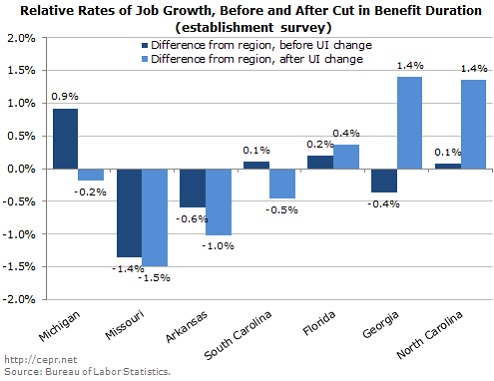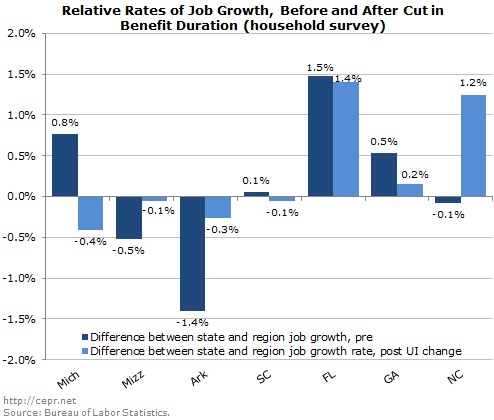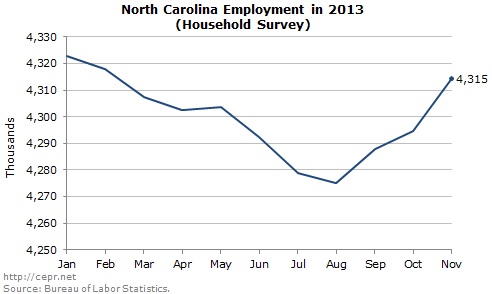January 09, 2014
Many of those arguing against extending unemployment insurance (UI) benefits claim that by shortening benefit duration we will give people more incentive to find jobs. This view is that we are effectively allowing people to avoid seriously looking for work by providing benefits for an extended period of time. If this were true, then it would be a good argument for not extending benefits.
The extent to which access to benefits is keeping people from finding jobs is actually an extensively researched topic. Insofar as this claim is true, we should expect that workers who are approaching the end of their benefit period end up taking jobs before or just after their benefit period expires. In fact, the research (Rothstein 2012 and Farber and Valletta 2013) finds that the overwhelming majority of people reaching the end of their benefit period simply leave the labor force.
The reason is that UI requires that people look for work in order to continue to receive benefits. After unsuccessfully looking for work for more than a year, many workers undoubtedly decide the effort is futile; therefore they stop looking.
Since a number of states have reduced their period of benefit duration during the downturn, we actually have a quick way of examining the extent to which the job creation story holds water. We can compare the job growth of states that have reduced benefits in the period before the duration was shortened with the period after it was shortened. For comparison, we looked at the rate of job growth for other states in the region that did not change benefit duration over the same period.
Table 1 shows the states where cuts in benefit duration have already gone into effect. While the shortening of benefit duration only applies to new applicants, if it has the effect of increasing incentives to work, it should be felt quickly. Workers who know that they have a shorter period to find employment before losing benefits are not likely to wait until the expiration of the benefit period before seriously looking for work. This means that any incentive effect should be visible in the data long before workers actually hit the end of the period of benefit duration.

Figure 1 shows the before and after picture using the establishment survey. It compares the rate of job growth in the state in the year before a cut in benefit duration went into effect with the growth in the year after the cut took effect. (Since the cut went into effect in North Carolina in June, the after period only has four months of data.) In both cases, the growth rate shown is the difference between the rate of job growth in the state and the average for other states in the region that did not change benefit duration.[1]

As can be seen there is no clear pattern in the change in relative growth rates in these data. Michigan goes from having a substantially more rapid rate of job growth than the other states in the region to having a less rapid rate of growth. Missouri and Arkansas both also see a modest deterioration in their rate of job growth compared to the rest of the region. South Carolina switches from having a slightly more rapid rate of growth than the rest of the region to having a less rapid pace of growth. Florida shows a gain in its growth rate relative to the rest of the region. Georgia goes from a growth rate that lagged the rest of the region to one that exceeds it. North Carolina also shows a gain relative to the rest of the region, albeit only over a five-month period.

Figure 2 shows the same comparison, but this time using the household survey. In this case also four of the seven states show a relative deterioration in the pace of employment growth relative to the rest of their region in the period after reducing the length of benefit duration.
North Carolina has often been highlighted in this debate because it imposed the sharpest cuts, reducing duration for those already receiving benefits, not just new applicants. In both the establishment and household survey it does show a pick-up in employment growth after this cut relative to the rest of the region. However this comparison is somewhat deceptive.
In North Carolina the pick-up in the household survey is driven by the fact that reported employment fell by 44,000 (1.0 percent) between January of 2013 and July of 2013, the base month for the before and after comparison as shown in Figure 3.

This sharp drop in employment just before the cut in benefit duration was almost certainly an anomaly in the data. However it made the growth in the period prior to the implementation of the cut in benefit duration appear worse, while making the growth in the period after the cut appear much better.
There may be a slightly better case for the cut in benefit duration having an impact in North Carolina using the establishment data, but even here the evidence is rather weak. This survey shows a gain of 30,100 jobs (0.74 percent) in the four months from after the cut in benefit duration was put in place. Almost half of these jobs (14,000) were in the Charlotte metropolitan area. Excluding Charlotte, the rate of job growth in the rest of the state actually fell slightly in the period following the cut in benefit duration.
This is noteworthy because the Charlotte metropolitan area straddles the border with South Carolina. If the argument is that cutting benefit duration spurred job growth in North Carolina, it is striking that this acceleration is only visible in a border area where many workers would not even qualify for benefits in North Carolina.[1]
While this sample is very limited and there are many potentially complicating factors, there is no evidence from the group of states that have recently shortened benefit duration of any positive impact on job creation and employment growth. The promotion of employment should not be used as a justification for not restoring extended unemployment benefits.
Eligibility for benefits in North Carolina would depend on a person’s work history in North Carolina. Presumably many workers in Charleston had a past work history on the South Carolina side of the border and therefore would be less likely to be eligible for benefits in North Carolina than workers elsewhere in the state.
The comparison states for Michigan and Missouri are Indiana, Illinois, Minnesota, Ohio, and Wisconsin. The comparison group for the southern states is Alabama, Kentucky, Louisiana, Mississippi, North Carolina, Oklahoma, Tennessee, Texas, and Virginia.






